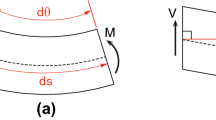Abstract
This work is divided into two parts; the first one presents the nonlinear methods of analyses for seismic design of structures. The first method is the nonlinear pushover procedure, which is based on the N2 method. The second method is the classical nonlinear time history analysis. The objective of this paper is to make a comparative study of an existing reinforced concrete building in Bonefro, Italy between static nonlinear analysis and time history analysis using flexibility-based finite element, and the sensitivity of the time history analyses to the seismic parameters. The second part presents an elegant method called Domain Reduction Method, which takes into account a small adjacent part of subsoil including structure. With this way the size of the problem to be solved is substantially reduced. All this through Z_Soil; engineering software based on the finite-element method.
Similar content being viewed by others
References
Antoniou, S. and Pinho, R. (2004). “Advantages and limitations of adaptive and non adaptive force-based pushover procedures.” Journal of Earthquake Engineering, Vol. 8, No. 4, pp. 497–522.
Aydinoglu, M. N. (2004). An improved pushover procedure for engineering practice: Incremental Response Spectrum Analysis (IRSA), International Workshop on Performance-based seismic design. Concepts and Implementation, Bled, Slovenia, June 28-July 1, In Press by Pacific Earthquake Research Center, PEER.
Belgasmia, M. and Moussaoui, S. (2013). “Comparaison of static pushover analysis in the case of small and large deformation with time history analysis using flexibility-based model for an existing structure.” International Journal of Current Engineering and Technologie, Vol. 3, No. 2, pp. 655–665.
Belgasmia, M., Spacone, E., Urbanski, A., and Zimmermann, Th. (2007). Seismic evaluation of constructions: Static pushover procedure and time history analysis for nonlinear frames, LSC Internal Report, Swiss Federal Institute of Technology Lausanne Switzerland.
Biggs, J. M. (1964). Introduction in structural dynamic, McGraw-Hill, New York.
Ciampi, V. and Carlesimo, L. (1986). “A nonlinear beam element for seismic analysis of structures.” Proceedings of 8th European. Conference on Earthquake Engineering, Lisbon.
Command, S. (2013). “Pushover analysis with zsoil taking soil into account.” Numerics in Geotechnics and Structures Symposium, 28 Years of Zsoil and Structure PC, Swiszerland.
Conte, J. P., Barbato, M., and Spacone, E. (2004). “Finite element response sensitivity analysis using force-based frame models,” International Journal for Numerical Methods in Engineering, Vol. 59, Issue 13, pp. 1781–1820.
Eurocode 8 (2003). Design of structures for earthquake resistance, european committee for standardization, Part 1: General Rules, Seismic Actions and Rules for Buildings.
Fajfar, P. (1999). “Capacity spectrum method based on inelastic demand spectra.” Earthquake Engineering and Structural Dynamics, Vol. 28, No. 9, pp. 979–993.
Fajfar, P. (2002). “Structural analysis in earthquake engineering — A breakthrough of simplified non-linear methods.” Proceedings of 12 th European Conference on Earthquake Engineering.
Fajfar, P., Kilar, V., Marusic, D., and Perus, I. (2005). “The extension of the n2 method to asymmetric buildings.” Proceedings of the 4th European Workshop on the Seismic Behaviour of Irregular and Complex Structures, No. 41, Thessaloniki, Greece.
Gazetas, G. (2006). Seismic design of foundation and soil-structure interaction, First European Conference on Earthquake Engineering and Seismology, Geneva, Swiszerland.
Hjelmstad, K. D. and Taciroglu, E. (2002). “Mixed methods and flexibility approaches for nonlinear frame analysis.” Journal of Constructional Steel Research, Vol. 58, Nos. 5–8, pp. 967–993.
Kaba, S. and Mahin, S. A. (1984). “Refined modeling of reinforced concrete columns for seismic analysis.” EERC Report 84/03, Earthquake Engineering Research Center, University of California, Berkeley.
Neuenhofer, A. and Filippou, F. (1998). “Geometrically nonlinear flexibilitybased frame finite element.” Journal of Structure Engineering. Vol. 124, No. 6, pp. 704–711.
Reynders, E. and Roeck, G. (2010). “A local Flexibility Method for Vibration-Based Damage Localization and Quantification.” Journal of Sound and Vibration, Vol. 329, No. 12, pp. 2367–2383.
Sabetta, F. and Pugliese, A. (1996). “Estimation of response spectra and simulation of non stationary earthquake ground motions.” Bulletin of the Seismological Society of America, Vol. 86, No. 2, pp. 337–352.
Spacone, E. (1994). Flexibility-based finite element models for the nonlinear static and dynamic analysis of concrete frame structures, PhD Thesis, Department of Civil Engineering, University of California, Berkeley.
Spacone, E., Filippou, F. C., and Taucer, F. F. (1996). “Fiber beamcolumn model for nonlinear analysis of R/C frames. I: Formulation, II: Applications.” Earthquake Engineering and Structural Dynamics, Vol. 25, No. 7, pp. 711–742.
Taucer, F. F., Spacone, E., and Filippou, F. C. (1991). A fiber beamcolumn element for seismic response analysis of reinforced concrete structures, EERC Report 91/17, Earthquake Engineering Research Center, University of California, Berkeley.
Urbaski, A., Spacone, E., Belgasmia, M., Sarf, J. L., and Zimmermann, Th. (2007). Static pushover analysis in Z_Soil.PC & related EUROCODE 8 regulations, Report 070202 Zace Services.
Valipour, H. R. and Foster, S. J. (2010). “A total secant flexibility-based formulation for frame elements with physical and geometrical nonlinearities.” Finite Elements in Analysis and Design, Vol. 46, No. 3, pp. 288–297.
Zeris, C. A. and Mahin, S. A. (1988). “Analysis of reinforced concrete beam-columns under uniaxial excitation.” Journal of Structure Engineering, Vol. 114, No. 4, pp. 804–820.
Zeris, C. A. and Mahin, S. A. (1991). “Behavior of reinforced concrete structures subjected to biaxial excitation.” Journal of Structure Engineering, Vol. 117, No. 9, pp. 2657–2673.
Zimmermann, Th., Truty, A., Urbanski, A., and Podles, K. (2008). Zsoil user manual, Zace Services, Switzerland.
Author information
Authors and Affiliations
Corresponding author
Rights and permissions
About this article
Cite this article
Mourad, B., Sabah, M. Comparison between static nonlinear and time history analysis using flexibility-based model for an existing structure and effect of taking into account soil using Domain Reduction Method for a single media. KSCE J Civ Eng 19, 651–663 (2015). https://doi.org/10.1007/s12205-015-0351-y
Received:
Revised:
Accepted:
Published:
Issue Date:
DOI: https://doi.org/10.1007/s12205-015-0351-y




